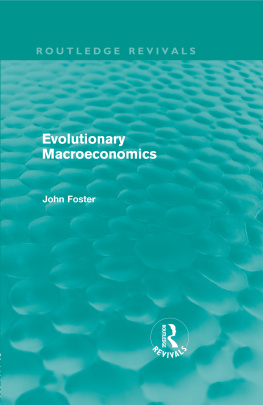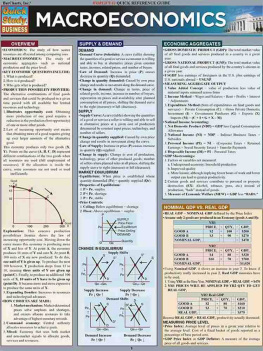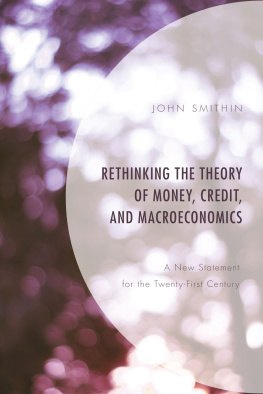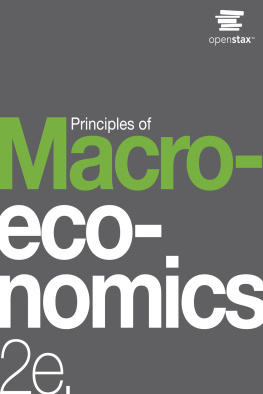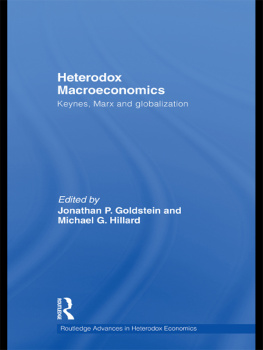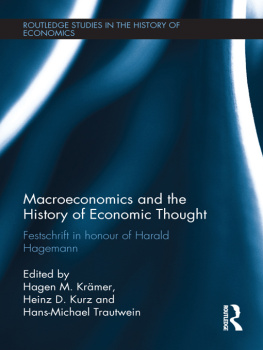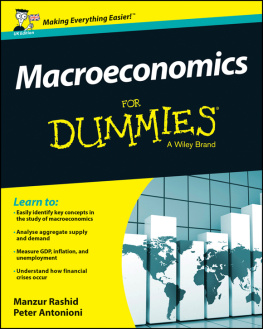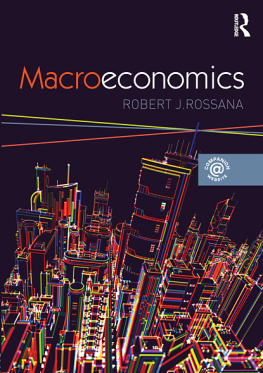Routledge Revivals
Evolutionary Macroeconomics
First published in 1987, Evolutionary Macroeconomics offers an evolutionary approach to macroeconomics as an alternative to contemporary new classical and Keynesian macroeconomics. In order to develop such an approach, an alternative view of the micro-foundations of macroeconomics is presented.
The book begins with a commentary on the state of macroeconomics and an evaluation of attempts to redevelop its underlying vision of economic behaviour. Particular attention is paid to the treatment of expectations and anticipations. The second part of the book presents a behavioural framework which is compatible with an evolutionary perspective on economic behaviour. The third part of the book discusses the implications of adopting an evolutionary approach to macroeconomic theory, empirical methods and policy design, culminating in a specific policy proposal to cure stagflation.
Evolutionary Macroeconomics
John Foster
First published in 1987
By Allen & Unwin
This edition first published in 2011 by Routledge
2 Park Square, Milton Park, Abingdon, Oxon, OX14 4RN
Simultaneously published in the USA and Canada
by Routledge
711 Third Avenue, New York, NY 10017
Routledge is an imprint of the Taylor & Francis Group, an informa business
1987 John Foster
All rights reserved. No part of this book may be reprinted or reproduced or utilised in any form or by any electronic, mechanical, or other means, now known or hereafter invented, including photocopying and recording, or in any information storage or retrieval system, without permission in writing from the publishers.
Publishers Note
The publisher has gone to great lengths to ensure the quality of this reprint but points out that some imperfections in the original copies may be apparent.
Disclaimer
The publisher has made every effort to trace copyright holders and welcomes correspondence from those they have been unable to contact.
ISBN 13: 978-0-415-67924-4 (hbk)
ISBN 13: 978-0-203-80517-6 (ebk)
Contents
The Bio-philosophical Foundations of
Macroeconomics |
General Behavioural Dynamics: from Structure to
Consciousness |
The Foundations of an Evolutionary Approach to
Economic Behaviour |
Economic Behaviour in the Short Run of
Evolutionary Time |
Structural Change in the Long Run of
Evolutionary Time |
An Evolutionary Framework for Macroeconomic
Analysis |
Preface
This book began, as many do, in dissatisfaction with orthodox modes of thought. It was towards the end of the 1970s when, amidst the computer printouts of an applied macroeconomist, notes began to appear questioning this and that about the nature of the hypotheses that were, purportedly, being put to the test using econometric methods. No notion of a book existed then but, none the less, in retrospect, the beginning of the enterprise was at that time. By 1980, when I visited the University of British Columbia, momentum increased, particularly when I was asked by Keizo Nagatani to read and comment on a draft of his, then forthcoming, book Macroeconomic Dynamics. His book made it clear that once the Keynesian model, that we are so familiar with, is set in the Marshallian dynamic context of temporary equilibrium, the prospect of verifying hypotheses, using econometric methods and fixed parameter modelling, is remote indeed. My note writing began to increase and my appetite for computer output began to diminish. There seemed little point in continuing applied research when its methodological basis was so much in question. And there seemed every reason to search for new ways of looking at the macroeconomy.
Thus began several years of foraying into fields beyond economics in an attempt to stand on the outside looking in, to gain a better perspective. It was to prove to be a thoroughly 'unprofessional' strategy, with a curriculum vitae in which the flow of published academic papers began to dry up, but an enormously valuable one in terms of learning. Only a small fraction of that learning, and the mounds of notes which accompanied it, is directly reflected in this book, but its indirect influence is everywhere. It was in 1983 that this book could be meaningfully said to have begun its physical existence. Visiting the University of Adelaide in that year I was asked to take a special course called 'Topics in Advanced Economic Theory' which carried the unique privilege that subject matter was unspecified. The course I gave was, loosely speaking, an extended version of persuading me that the notion that macroeconomics should be set in an evolutionary context should be extended into a book. By the end of 1985 the process of distilling my compiled notes had created the remainder of the book.
The result is a book which is devoted to persuading students of economics that there is a case for an evolutionary approach to macroeconomics and that, furthermore, without such an approach, problems such as unemployment and inflation can neither be properly understood nor easily solved. Given the novelty of such a proposition, much of the book is devoted to explaining how evolutionary macroeconomics is different from orthodox macroeconomics, where such ideas come from and whether it is possible to develop a simple analytical framework within which evolutionary tendencies can be discussed. Given that phenomena such as inflation and unemployment are viewed as by-products, or manifestations, of more central evolutionary tendencies in the economic system, less attention is paid to formulating 'testable hypotheses' in the traditional manner and more to policy formulation, with these tendencies in mind. As such, it is very hard to pigeon-hole the book into accepted macroeconomic schools of thought. This is both its strength, providing the basis for a possible new consensus, and a weakness, encouraging rejection by all schools of thought.
The search for a macroeconomic perspective which transcends existing schools of thought really started at the beginning of my academic career at the University of Manchester in the early 1970s. At that time I was exposed to 'monetarist' thought through the sensible critiques of Keynesianism by David Laidler while, at the same time, a vocal post-Keynesian group expounded the advantages of moving Keynesianism in the direction of political economy. It was possible to see great merit in the view of both Milton Friedman and Joan Robinson from their own very different perspectives! Of course, the problem with learning two economic languages instead of one was that it bred an ambivalence which proved uncomfortable for both camps. However, my career took me to the University of Glasgow where such divisions were of no great importance and I was introduced to a third perspective: that of Adam Smith whose writings I read carefully and contemplated for the first time. The seeds of an evolutionary perspective were sown.
Whether or not the evolutionary perspective on macroeconomics, that is no more than a sapling in this book, will grow and survive depends greatly on its wide appeal to readers of all types. It certainly has strong roots, in the form of Keynes's theory of effective demand, and flexibility, which comes from explicit acknowledgement of the validity of the new Classical school's critique of Keynesianism. Furthermore, the book has been written in as non-technical a way as possible to permit readers from widely varying backgrounds to digest its contents. However, that does not mean that the arguments are necessarily straightforward. It is hoped that difficulty in comprehension will draw readers towards the extensive references provided, most of which are not normally encountered in a book on macroeconomics. An undergraduate with a good grounding in intermediate macroeconomics should find no difficulty with the 'commentary' in the first third of the book, after which he or she may be even better placed than a specialized academic economist to cope with the second third of the book. The last third of the book deals with material which relates to topics which a third/fourth year undergraduate or a postgraduate in economics would be dealing with in their coursework in macroeconomics. Indeed, it is hoped that the book will prove attractive to such students as a companion to their more orthodox material and provide the basis for seminar discussion, term papers, etc. Also, students who are fortunate enough to be exposed to Richard Nelson and Sidney Winter's An Evolutionary Theory of Economic Change in their advanced microeconomics course will find this book a highly compatible companion. Finally, it is hoped that the penultimate chapter of the book on stagflation policy will be of interest to a wide range of readers interested in economic policy.

